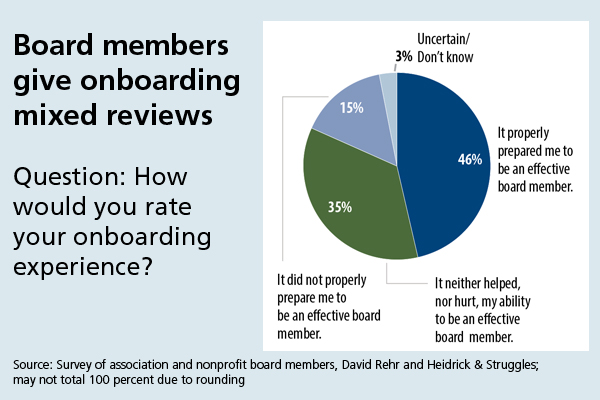New survey asks: How prepared is the board to lead the organization?
New survey asks: How prepared is the board to lead the organization?
- October 10, 2017 |
-
 LORI SHARN BRYANT
LORI SHARN BRYANT


More than 500 association and nonprofit board members respond to survey
The CEO's job is a whole lot easier if there is a high-functioning board of directors who understand the role of the board and basics about the organization. But that's not always the case.
A new survey of more than 500 board members of associations and other nonprofit groups shows good news and bad news on this front.
The good news: 65 percent of respondents ranked setting the vision and mission of the organization as a top-three responsibility. Only 3 percent viewed oversight of day-to-day operations as a top responsibility.
Less-than good: Just 46 percent of respondents said their onboarding experience properly prepared them to be effective, while 15 percent said onboarding did not give them a good foundation.
The survey was conducted jointly by executive search firm Heidrick & Struggles and the Antonin Scalia Law School at George Mason University.
Report co-author and executive recruiter Julian Ha said board members were very positive about their service being a good use of their professional time, even as demands on the board have been increasing.
Respondents said they devoted an average of 172 hours per year to board work, but there was great individual variation, ranging from a low of four hours to thousands of hours annually.
"We were pleasantly surprised that people are happy to be serving in these time-consuming roles," said Ha, who leads the search firm's government affairs and trade association practices. "A happy board means job security for that CEO."
The report was co-authored by Bill Hudson of Heidrick & Struggles and former association CEO David Rehr, now a professor of law at George Mason.
Educating the board
Scott Melville, CEO of the Consumer Healthcare Products Association, said his 39-member board has frequent turnover. He realized a few years after becoming CEO that CHPA needed to do a better job educating people at the start of their term. The catalyst: the moment a newcomer asked Melville, in a whisper, the identity of someone making a presentation to the board. The presenter was a senior staffer who had been with CHPA for decades and was "legendary" in the industry, Melville said.
"That was just such a telling moment for me, that we have board members who don't know senior staff," Melville said.
Now there is a formalized board orientation, Melville said. To make it as convenient as possible, the session is held a few hours before the new board member's first meeting. They come to CHPA's office—possibly for the first and only time—to meet the staff and hear presentations clarifying what their role is (governance, making policy decisions) and what it isn't (day-to-day operations). Setting clear parameters and expectations early on avoids potential problems later, he said.
Board members also get instruction in the differences between nonprofit, mission-driven organizations and private enterprises, and even on the differences between CHPA, as a nonprofit trade group, and its charitable foundation.
"You certainly want informed decision makers," Melville said. "Having an appropriate onboarding process allows them to be the most effective board member they can be in the limited time we get to have them."
Melville is a member of Heidrick & Struggles' Association Leadership Council.
Taking responsibility
The survey was conducted earlier this year via email. Individualized links were sent to 5,591 randomly selected board members; 509 people completed the survey.
About two-thirds of the respondents, 64 percent, cited setting "the broad direction of the organization" as one of their top responsibilities, just below setting the vision and mission. Fifty-four percent put overseeing organizational finances and performance into their top-three basket.
Just 41 percent of the surveyed board members named overseeing and evaluating the CEO as a top responsibility. Often—particularly on larger boards—that oversight is tasked to a subset of the board.
Melville said a 13-member executive committee—rather than CHPA's entire board—provide feedback on his performance and determine his salary.
Board members were also asked to name their single toughest decision during their tenure. Twenty-four percent identified a financial decision, such as dramatic revenue growth or decline. Twelve percent said the toughest decision was removing the CEO, while 10 percent said it was hiring the CEO.
Download the full report: Association and Nonprofit boards, Maximizing Effective Service
